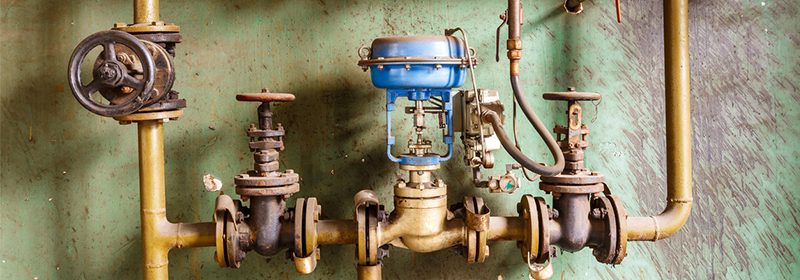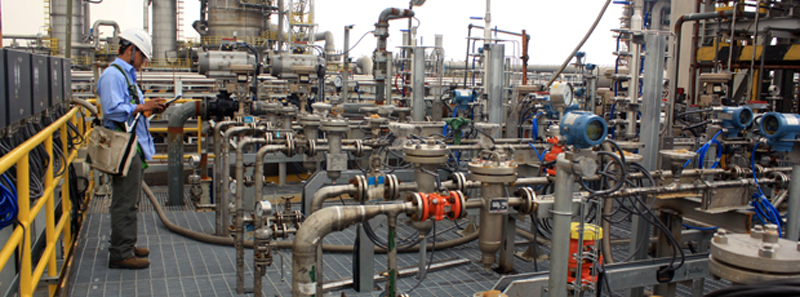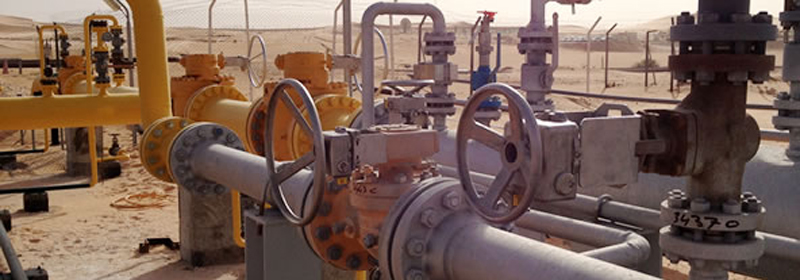COVNA, an automation solution provider. We focus on manufacturing actuator valves since 2000.
Corrosion is one of the important factors causing valve damage, therefore, in the use of valves, corrosion protection is the first consideration.
Principle Of Valve Corrosion
The corrosion of metals is mainly caused by chemical corrosion and pitting chemical corrosion, while the corrosion of non-metallic materials is generally caused by direct chemical and physical action.
1. Chemical Corrosion
Under the condition of no electric current, the surrounding medium acts directly with the metal and destroys it, such as high temperature dry gas and non-electrolyte solution corrosion to the metal.
2. Electrochemical Corrosion
The main form of corrosion is that the metal contacts the electrolyte and produces a flow of electrons that destroys itself in electrochemical action.
The corrosion of common acid-alkali-salt solution, atmospheric corrosion, soil corrosion, seawater corrosion, microbial corrosion, pitting corrosion and crevice corrosion of stainless steel are all electrochemical corrosion.
Electrochemical corrosion occurs not only between two substances that can act chemically, but also because of the difference in the concentration of solution, the concentration of oxygen around it, the slight difference in the structure of the substances, and so on And get the power of corrosion, so that low potential, in the position of the metal in the Yang plate loss.

General Measures Of Valve Anti-Corrosion
1. Choose Corrosion Resistant Materials According To The Medium
Many media are corrosive, its corrosion principle is very complex, even in the same medium using the same valve material, if the media concentration, temperature and pressure are different media on the material corrosion is also different.
The corrosion rate increases 1 ~ 3 times with the increase of the medium temperature by 10°C. The medium concentration has a great influence on the corrosion of valve material.
2. Selection Of Valve Material Under Different Working Conditions
(1). Sulfuric Acid Medium
The corrosion resistance of carbon Steel and cast iron is better when the concentration of sulfuric acid is above 80% and the temperature is below 80°C
But carbon steel and cast iron are not suitable for high-speed flow of sulfuric acid;
Ordinary stainless steel, such as 304(0Cr18Ni9) , 316(0Cr18Ni12Mo2Ti) on sulfuric acid medium also limited use, so the delivery of sulfuric acid pump valve usually used high silicon cast iron (casting and processing difficulties) , high alloy stainless steel (no. 20 Alloy) manufacturing;
Fluoroplastics has good resistance to sulfuric acid. It is a more economical choice to use fluoroplastic pump valve (F46) . If the pressure is too large, temperature rise, the point of use of the plastic valve was impacted, it can only choose more expensive ceramic ball valve.
(2). Hydrochloric Acid Medium
Most metal materials are not resistant to hydrochloric acid corrosion (including various stainless steel materials) , high ferrosilicon containing molybdenum can only be used at 50°C, less than 30% hydrochloric acid.
In contrast to metallic materials, most non-metallic materials have good corrosion resistance to hydrochloric acid, so lined rubber pumps and plastic pumps (such as polypropylene, fluoroplastics, etc.) are the best choice for the transport of hydrochloric acid.
But if the temperature of such a medium exceeds 150°C, or the pressure is greater than 16 kg, any plastic (including polypropylene, fluoroplastics and even polytetrafluoroethylene) will not be up to the task.
(3). Nitric Acid Medium
Most metals are destroyed by rapid corrosion in nitric acid. Stainless steel is the most widely used nitric acid resistant material. It has good corrosion resistance to nitric acid of all concentrations at room temperature.
It is worth mentioning that the corrosion resistance of stainless steel containing Molybdenum (such as 316,316L) to nitric acid is not as good as common stainless steel (such as 304,321).
For high temperature nitric acid, titanium and titanium alloy materials are usually used.
(4). Chlorine Gas (liquid chlorine) Medium
The resistance of most metal valves to chlorine corrosion is limited, especially in the case of chlorine with water, including a variety of alloy valves.
For Chlorine Teflon Valve is a good choice, but teflon valve with a little longer time, torque increases, Teflon aging will be highlighted.
The original teflon valve was replaced by teflon ceramic ball core. The self-lubricating property of ceramics and the corrosion resistance of Teflon would have better effect.
(5). Ammonia (Ammonia Hydroxide) Medium
Most metal and non-metal corrosion in liquid ammonia and ammonia (ammonia hydroxide) are very mild, only copper and copper alloys are not suitable for use.
(6). Alcohols, Ketones, Esters, Ethers
The common alcohols, ketones, esters and ethers are basically non-corrosive, common materials are applicable, specific selection should also be based on the properties of the media and related requirements to make a reasonable choice.
It is also worth noting that ketones, esters, ether on a variety of rubber is soluble, in the selection of sealing materials to avoid mistakes.
3. Use Nonmetallic Materials
Non-metallic materials have excellent corrosion resistance. As long as the temperature and pressure of valves meet the requirements of non-metallic materials, the use of non-metallic materials can not only solve the problem of corrosion resistance, but also save precious metals and reduce the cost of valves.
Now more and more valves use nylon, polytetrafluoroethylene and other plastics as well as natural rubber and synthetic rubber to make a variety of sealing surface, sealing ring, these non-metallic materials good corrosion resistance, sealing performance, especially suitable for use in the medium with particles.
However, its application is limited because of its low strength and heat resistance. Flexible graphite makes non-metallic materials enter the high temperature field, solves the long-term difficult to solve the packing and gasket leakage problem, and is a good high temperature lubricant.

4. Spray Paint
Paint is one of the most widely used anti-corrosion means, and it is an indispensable anti-corrosion material and identification mark in valve products.
The coating is usually made of synthetic resin, rubber slurry, vegetable oil, solvent and so on. It covers the metal surface, insulates the medium and atmosphere, and achieves the purpose of anticorrosion. The paint is coloured to indicate the material of the valve.
Paint is mainly used in water, salt water, sea water or atmospheric corrosion is not too strong environment.
5. Add A Corrosive
The mechanism of inhibitor controlling corrosion is that it promotes the polarization of battery. The inhibitor is mainly used in medium and packing. The addition of inhibitor in medium can slow down the corrosion of equipment and valve.
Chromium-nickel stainless steel becomes active in a large range of concentration in oxygen-free sulfuric acid and corrodes seriously, but when a small amount of oxidant such as copper sulfate or nitric acid is added, the stainless steel can be changed into passive state and a protective film is formed on the surface To Stop the erosion of the medium.
In hydrochloric acid, if a small amount of oxidant is added, the corrosion of titanium can be reduced. Water is often used as pressure testing medium, easy to cause valve corrosion, in the water to add a small amount of sodium nitrite can prevent water corrosion of the valve.
There are chlorides in the asbestos packing, which corrode the valve rod greatly. The method of washing with distilled water can reduce the content of chlorides.
To protect the valve stem from corrosion by asbestos packing, corrosion inhibitors and sacrificial metals are applied to the asbestos packing and the valve stem.
The corrosion inhibitor is composed of Sodium Nitrite, sodium chromate and solvent. Sodium Nitrite and sodium chromate can form a passivation film on the surface of the valve stem to improve the corrosion resistance of the valve stem. The solvent causes the corrosion inhibitor to dissolve slowly and acts as a lubricant.
In fact, zinc is also a kind of corrosion inhibitor. It can first combine with chloride in Asbestos, so that the chloride will have less contact with valve rod metal.
Coating if the addition of red, calcium lead and other corrosion inhibitors, sprayed in the valve surface can prevent atmospheric corrosion.
6. Electrochemical Protection
There are two kinds of electrochemical protection: anodic protection and cathodic protection.
Anodic protection is to protect the metal anode into the direct current, so that the anode potential increases in a positive direction, when increased to a certain value, the metal anode surface formed a dense protective film, that is, passivation film At this time the corrosion of the metal cathode is greatly reduced. Anodic protection is suitable for metals that are easily passivated.
Cathodic protection is to be protected metal as a cathode, plus DC, so that its potential to the negative direction of the reduction, for it reaches a certain potential, corrosion current speed reduction, metal protection. In addition, cathodic protection may be provided by a metal with a more negative electrode potential than the protected metal. When Zinc is used to protect iron, the zinc is corroded. Zinc is called a sacrificial metal.
In production practice, anode protection is less used and cathode protection is more used. This cathodic protection method is an economical, simple and effective method for large valves and important valves.
7. Surface Coatin
Metal surface treatment processes include surface coating, surface penetration, surface oxidation and passivation, etc. . Its purpose is to improve the corrosion resistance of metals, improve the Mechanical Properties of metals, surface treatment is widely used in valves.
Common Zinc, chromium, and oxide (bluing) treatments are used to improve the resistance to atmospheric or dielectric corrosion of valve connection bolts.
Other fasteners, in addition to the above methods, can also be used as the case of surface treatment process such as phosphating passivation.
The sealing surface and the closing parts of small caliber are usually treated by nitriding or boronizing to improve its corrosion resistance and wear resistance. If the valve disc made of 38CrMoAlA, the nitriding layer thickness ≥014 mm.
The valve stem is usually treated by nitriding, boronizing, chromium plating and nickel plating to improve its corrosion resistance, wear resistance and abrasion resistance.
Different surface treatment for different stem material and working environment, in the atmosphere or steam medium and asbestos packing contact stem, can use hard chromium plating and gas nitriding process (stainless steel is not suitable for ion nitriding process) .
In the hydrogen sulfide gas environment of the valve stem, the use of electroplating high-phosphorus nickel coating has better protection performance.
Ion and gas nitriding can improve the corrosion resistance of 38CrMoAlA, but hard chromium plating is not suitable. 2Cr13 can resist ammonia corrosion after quenching and tempering, carbon steel nitrided by gas can also resist ammonia corrosion, but all NI-P coatings are not resistant to ammonia corrosion.
The gas nitrided 38CrMoAlA material has excellent corrosion resistance and comprehensive performance and is often used to make valve stem. Small-bore valve bodies and handwheels are often chrome-plated to improve their corrosion resistance and trim valves.
8. Thermal Spraying
Thermal spraying is a process for preparing coatings, which has become one of the new technologies for surface protection and strengthening of materials.
Thermal spraying is a kind of high energy density heat source (gas combustion flame, electric arc, plasma arc, electric heating, gas explosion, etc.) which is used to melt metal or non-metal materials and then spray them onto the surface of the pretreated substrate by atomization A surface strengthening process method for forming a spray coating or simultaneously heating a substrate surface to remelt the coating on the substrate surface to form a spray welding layer.
Most metals and their alloys, metal oxide ceramics, metal ceramic composites, and hard metal compounds can be coated on metal or non-metal substrates by one or more thermal spraying methods.
Thermal spraying can improve the surface corrosion resistance, wear resistance, high temperature resistance, and extend the service life.
Thermal spraying special functional coating, with heat insulation, insulation (or conductive) , sealing, self-lubrication, thermal radiation and electromagnetic shielding and other special properties. Parts can also be repaired by thermal spraying.
9. Environmental Control
The atmosphere is full of dust, water vapor and smoke, especially in the production environment, from chimneys and equipment and other emissions of toxic gases and dust, will cause varying degrees of valve corrosion.
Regular cleaning and purging of valves and regular oiling, as specified in the operating procedures, is an effective measure to control environmental corrosion.
Stem installation cover, ground valve installation wells and valve surface spray paint is also an effective way to prevent corrosion of the valve material.
Environmental temperature rise and air pollution will accelerate the corrosion of equipment and valves in the closed environment, should try to use open plant or ventilation cooling measures to slow down environmental corrosion.
10. Improve process and structure
The anti-corrosion protection of valve should be considered from the beginning of design. If the valve structure design is reasonable and the processing method is correct, the corrosion of valve can be greatly reduced.
Therefore, it is necessary to improve the corrosion-prone parts of the valve to meet the requirements of different working conditions.
(1). The gap at the valve joint can cause oxygen concentration difference battery corrosion, therefore, the valve stem and the closing piece joint, as far as possible not to use the screw connection form.
(2). Spot welding and lap welding are easy to produce corrosion, valve welding should be double-sided butt welding and continuous welding.
(3). Valve thread connection should be used polytetrafluoroethylene, not only has a good seal, and corrosion.
(4). Valve medium is not easy to flow place, easy to be corroded, in addition to install the valve when not upside down and use the valve pay attention to discharge deposition medium, in the manufacture of valve parts, should try to avoid dent structure, the valve try to set discharge hole.
(5). The galvanic contact between different metals can promote the corrosion of anode metal. When selecting materials, attention should be paid to avoid the metal contact which has big metal potential difference and can not produce passive film.
(6). In the process of machining, especially welding and heat treatment, stress corrosion will occur. The machining method should be improved, and annealing treatment should be used after welding.
(7). Improved Surface finish rating for stem and other components, good Surface finish and corrosion resistance.
(8). Improved packing and gasket processing technology and structure, using flexible graphite, plastic packing, flexible graphite paste gasket and polytetrafluoroethylene gasket, not only improve sealing performance, and reduce the valve stem and flange sealing surface corrosion.
Points For Attention In Anti-corrosion Of Valve Parts
1.Main Cause Of Stem Corrosion
The corrosion damage of valve body is mainly caused by corrosive medium, and the valve stem corrosion is mainly caused by packing.
Not only corrosion medium to stem corrosion damage, and steam and water can also make the stem and packing contact spots. In particular, stored in the warehouse of the Valve, will also occur stem pitting corrosion. This is the electrochemical corrosion of the packing to the valve stem.
Now the most widely used filler is based on asbestos packing, Asbestos materials contain certain chloride ions, in addition to potassium, sodium, magnesium plasma, these are corrosion factors.
2.Corrosion Protection of Valve Stem
Do not fill the valve during storage. No packing, the loss of the stem electrochemical corrosion factors, can be long-term storage without corrosion.
Surface the stem. Such as chromium plating, nickel plating, nitriding, boronizing, zinc and so on.
Reduce Asbestos impurities. The chlorine content in asbestos can be reduced by washing it with distilled water, thus reducing its corrosiveness.
Add Corrosion inhibitor to asbestos packing. The corrosion inhibitor can inhibit the corrosiveness of chloride ion. Like a sodium nitrite.
Adding sacrificial metals to asbestos. This is a lower than the valve stem potential of the metal as a victim. This chloride corrosion occurs first on the sacrificial metal to protect the stem. Can Be used as a sacrificial metal, such as zinc powder.
Use polytetrafluoroethylene protection. Polytetrafluoroethylene have excellent chemical stability and dielectric properties, current can not pass through, if the asbestos packing is impregnated with polytetrafluoroethylene, corrosion will be reduced. You can also wrap the asbestos packing in polytetrafluoroethylene strips and then fill the stuffing boxes.
Improving the finish of the processing can also reduce the electrochemical corrosion.

Corrosion And Protection Of Closing Parts
1. Main Causes Of Corrosion Of Closed Parts
The closing parts are often washed by the fluid, which speeds up the development of corrosion. Some disc, although the use of better materials, but corrosion damage is still faster than the valve body.
The upper and lower closing parts are connected with the valve stem and the valve seat by common thread. The connecting part is short of oxygen than the general part, which is easy to cause the oxygen concentration difference battery to corrode. Some closure seal surface used in the form of pressure, due to a tight fit, a little gap, oxygen concentration cell corrosion will occur.
2. Points To Note When Closing A Piece Of Anti-Corrosion
Use corrosion resistant materials whenever possible. The closure is light in weight, but plays a key role in the valve, as long as it is resistant to corrosion, even with a little valuable material.
The structure of the closure is improved so that it is less eroded by the fluid.
The connection structure is improved to avoid the oxygen concentration difference cell.
In valves below 200°c, the use of polytetrafluoroethylene as packing material at the joint of the closing piece and the seal face reduces corrosion at these locations.
While considering the corrosion resistance, attention should also be paid to the erosion resistance of the material. To use a strong erosion-resistant material for closing parts.
Post time: Jul-28-2021




